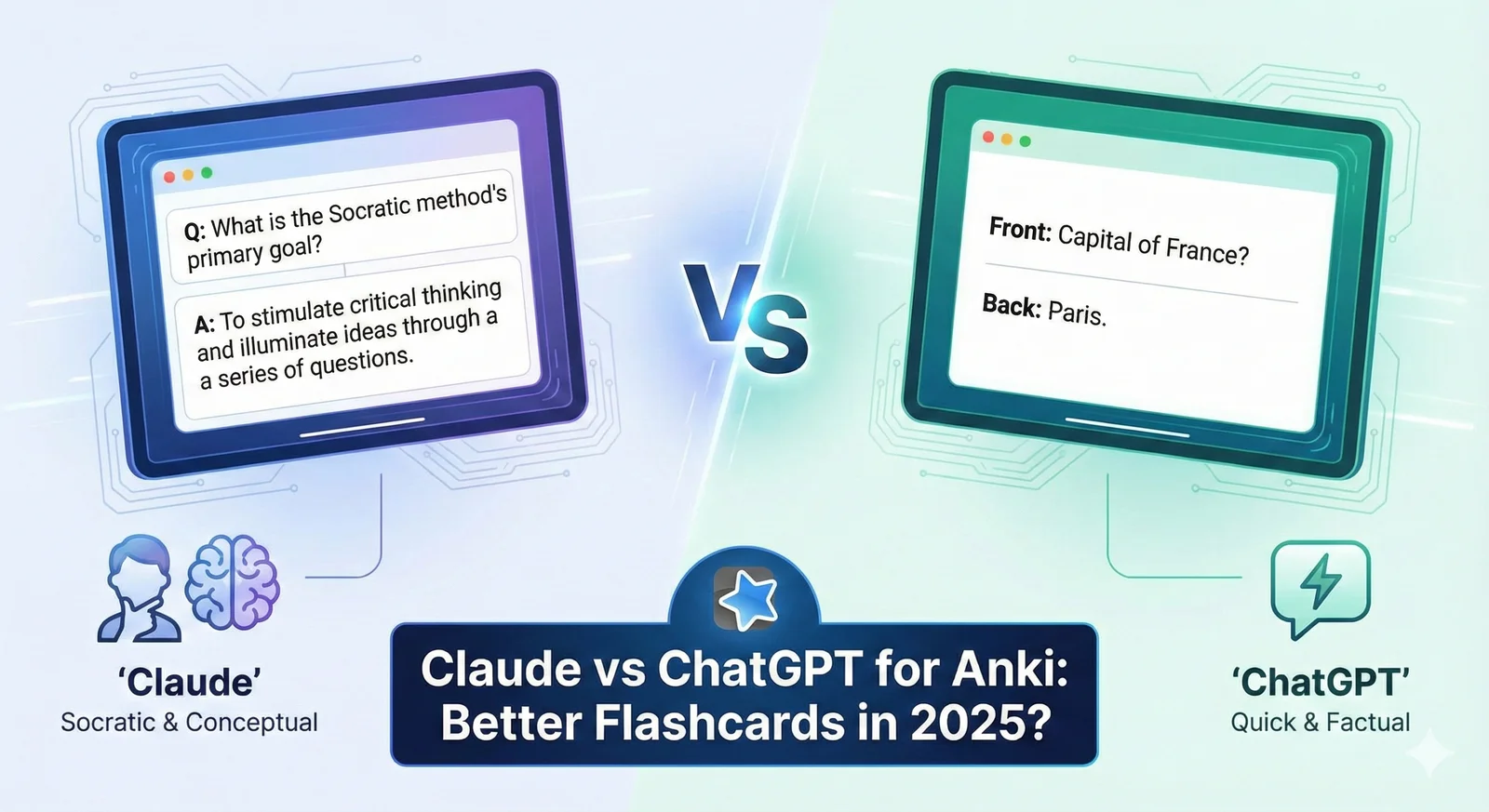
Claude vs ChatGPT for Making Anki Cards: Which AI Tool Creates Better Flashcards in 2025?
Head-to-head comparison of Claude and ChatGPT for generating Anki flashcards. Real examples, prompt templates, and quality benchmarks for medical students and learners.
TL;DR
Head-to-head comparison of Claude and ChatGPT for generating Anki flashcards. Real examples, prompt templates, and quality benchmarks for medical students and learners.
Table of Contents
Need help turning messy notes into clean flashcards?
MemoForge pulls highlights, structures prompts, and exports straight to Anki so your study time stays focused on recall.
Claude vs ChatGPT for Making Anki Cards: Which AI Tool Creates Better Flashcards in 2025?
The AI education wars heated up in 2025. Anthropic launched Claude for Education with university partnerships. OpenAI made ChatGPT Plus free for college students. Meanwhile, 86% of students globally now use AI for studying. The question isn't whether to use AI for flashcard creation—it's which tool to choose.
Here's our head-to-head comparison for generating Anki cards, with real examples, benchmarks, and prompts you can copy today.
The Core Difference: Teaching Styles
Claude and ChatGPT approach education differently, and this shapes the flashcards they produce.
Claude's "Learning Mode" uses Socratic questioning. It asks you to think before giving answers. When generating flashcards, it tends to create cards that test understanding, not just recall.
ChatGPT's generalist approach prioritizes direct answers and broad coverage. It generates cards faster and covers more ground, but the cards often test surface-level facts.
Neither approach is wrong—they serve different purposes. Let's see how this plays out in practice.
Real Example: Anatomy Chapter Test
We generated 50 flashcards from the same anatomy chapter (the brachial plexus) using both tools. Here's what happened:
Claude's Output
Q: A patient can't flex their elbow or supinate their forearm after a shoulder injury. Which nerve is likely damaged, and what anatomical relationship explains this vulnerability?
A: Musculocutaneous nerve. It pierces the coracobrachialis muscle, making it vulnerable to shoulder trauma.
Characteristics:
- Longer questions with clinical context
- Answers include reasoning
- Fewer total cards (42 from the chapter)
- Higher atomicity issues—some cards combined concepts
ChatGPT's Output
Q: What muscles does the musculocutaneous nerve innervate?
A: Coracobrachialis, biceps brachii, brachialis
Characteristics:
- Direct, factual questions
- Concise answers
- More total cards (58 from the chapter)
- Better atomicity—one fact per card
- Some cards lacked clinical relevance
The Benchmark Results
| Metric | Claude | ChatGPT |
|---|---|---|
| Cards generated | 42 | 58 |
| Factually accurate | 40/42 (95%) | 54/58 (93%) |
| Proper atomicity | 34/42 (81%) | 51/58 (88%) |
| Clinical relevance | 38/42 (90%) | 29/58 (50%) |
| Time to generate | 4 min | 2.5 min |
Benchmarks based on our internal test of 50 anatomy cards.
When Claude Excels
Choose Claude when you need:
Conceptual understanding cards. Claude naturally creates "why" and "how" cards, not just "what" cards. For subjects where mechanism matters—physiology, pharmacology, pathology—this is valuable.
Clinical reasoning practice. Medical students preparing for clinical rotations benefit from Claude's case-based framing.
Complex topic synthesis. When you need cards that connect ideas across systems, Claude's tendency toward longer context helps.
Learning while creating. Claude's Socratic approach means you engage with the material during card generation, not just after.
Best Claude Prompt for Anki Cards
I'm studying [TOPIC] for [EXAM/PURPOSE]. Generate Anki flashcards from the following text.
Requirements:
- Create separate cards for facts, mechanisms, and clinical applications
- Each card tests ONE concept
- Include the reasoning in answers, not just facts
- Format: Q: [question] / A: [answer]
- Flag any areas where the text is ambiguous
[PASTE YOUR TEXT]
When ChatGPT Wins
Choose ChatGPT when you need:
High-volume card generation. ChatGPT produces more cards faster. For subjects requiring broad coverage—like learning 300 drugs—speed matters.
Straightforward factual recall. If you're memorizing lists, classifications, or definitions, ChatGPT's direct approach creates cleaner cards.
Multiple-choice preparation. ChatGPT excels at generating question stems that mirror standardized test formats.
Wider knowledge base. ChatGPT handles obscure topics better. Claude occasionally admits uncertainty; ChatGPT pushes through (for better or worse).
Best ChatGPT Prompt for Anki Cards
Create Anki flashcards from this text for [SUBJECT] studying.
Rules:
1. ONE fact per card (atomic)
2. Use cloze deletions for lists: c1term
3. Keep questions under 20 words
4. Keep answers under 30 words
5. No filler words
6. Output format: Q: / A:
Generate [NUMBER] cards from:
[PASTE YOUR TEXT]
The Hybrid Approach
Here's what actually works best: use both tools strategically.
Step 1: Initial generation with ChatGPT. Get broad coverage quickly. ChatGPT will create 50-100 cards from a chapter in minutes.
Step 2: Quality review with Claude. Paste your ChatGPT cards and ask Claude: "Review these flashcards for accuracy, atomicity, and clinical relevance. Suggest improvements."
Step 3: Gap identification with Claude. After reviewing, ask: "What important concepts from this chapter are missing from these cards?"
Step 4: Concept cards with Claude. Generate additional cards for mechanisms, reasoning, and connections that ChatGPT missed.
This workflow takes more time but produces superior decks. It's also manual and tedious—copy-pasting between tools adds friction and errors. That's the pain MemoForge removes by keeping generation, quality scoring, and Anki export in one flow.
Cloze Deletion Comparison
Cloze deletions are popular for medical Anki. Here's how each tool handles them:
Claude tends to create meaningful cloze deletions:
The c1musculocutaneous nerve is tested by checking c2elbow flexion and c3forearm supination.
ChatGPT creates more but sometimes arbitrary deletions:
The c1musculocutaneous nerve innervates the c2coracobrachialis, c3biceps brachii, and c4brachialis.
Both work. Claude's feel more like active recall; ChatGPT's feel more like fill-in-the-blank.
The Accuracy Question
Both tools make mistakes. In our testing:
- Claude occasionally oversimplified mechanisms or added qualifiers that weren't in the source
- ChatGPT occasionally got details wrong or invented plausible-sounding but incorrect facts
Neither should be trusted blindly. The "AI-assisted, human-approved" philosophy matters here—use AI to draft, but verify before studying.
Does Generation Method Affect Retention?
Research from 2025 memory science suggests the generation method matters less than your engagement afterward. Cards created by AI versus cards you wrote yourself show similar retention if you review the AI cards before adding them to your deck.
The danger is passive card creation: generating 500 cards from a PDF and importing without review. You lose the encoding benefit of writing cards, and you're stuck with quality issues you won't notice until review.
The solution: always read through generated cards once. Edit the bad ones. This light engagement restores most of the learning benefit.
Speed vs Quality Trade-offs
Here's the real math for a medical student:
Manual card creation: 3-5 minutes per high-quality card AI with review: 30 seconds per card (including verification) AI without review: 5 seconds per card
If you're creating 50 cards from a lecture:
- Manual: 2.5-4 hours
- AI with review: 25 minutes
- AI without review: 4 minutes
The middle option wins. You save 90% of the time while maintaining quality control.
How MemoForge Fits This Workflow
Here's where the workflow gets even smoother.
MemoForge handles the friction between AI generation and Anki import:
- Upload your PDF of lecture notes or textbook chapter
- AI generates cards with context from surrounding pages
- Quality scoring flags cards that need review
- Auto-improvement refines low-quality cards
- Direct Anki export with proper formatting and audio
You skip the copy-paste between ChatGPT/Claude and Anki. You skip the manual formatting. And you get quality control built into the pipeline.
For students generating hundreds of cards weekly, this automation matters.
Prompt Templates to Copy
Claude: Mechanism-Focused Cards
Generate Anki flashcards explaining the mechanisms in this text. For each mechanism:
- Card 1: What triggers it
- Card 2: What happens step-by-step
- Card 3: What's the result/clinical significance
Format as Q: / A: pairs. Keep answers under 40 words.
[TEXT]
ChatGPT: High-Volume Factual Cards
Create 30 Anki flashcards from this text. Rules:
- Atomic: one fact per card
- Direct: no unnecessary words
- Testable: clear right/wrong answer
- Format: Q: / A:
Prioritize high-yield facts for [EXAM NAME].
[TEXT]
Either Tool: Cloze Deletions
Convert this text into Anki cloze deletion cards.
Rules:
- Use c1 format
- Maximum 3 deletions per card
- Each deletion should test recall of a key term or number
- Surrounding text should provide enough context
[TEXT]
The Verdict
For medical students: Start with ChatGPT for volume, refine with Claude for concepts. Or use MemoForge to automate the entire pipeline.
For language learners: ChatGPT's broader knowledge base and faster generation make it better for vocabulary. Claude's better for grammar explanations.
For professional certification: Depends on the material. Factual exams (like Series 7) favor ChatGPT. Conceptual exams (like CFA) favor Claude.
For everyone: Don't trust either tool completely. The best flashcards come from AI drafts that you've reviewed and edited. Active engagement with generated cards maintains quality and preserves learning benefits.
The AI tools keep improving. What matters is your workflow: fast generation, quality review, and consistent study. Get those right, and either tool will serve you well.
Ready to skip the copy-paste workflow? MemoForge turns your PDFs into reviewed, formatted Anki cards automatically—with quality scoring and audio generation included. Try it free and see how fast your deck can grow.
Related Articles

FSRS vs SM-2: The Complete Guide to Anki's New Algorithm for Medical Students
Everything you need to know about switching from SM-2 to FSRS in Anki. Step-by-step migration guide, optimal settings for medical school, and real data showing 20-30% fewer daily reviews.

Anki Backlog Rescue: Settings, Habits, and Filters to Clear Reviews Fast
Pause new cards, set time-based review caps, use parent deck limits, and build rescue filtered decks to eliminate your Anki backlog without burnout.

How to Use Anki: Step-by-Step Beginner Guide (2025)
Install Anki, build your first deck, choose the right settings, and set a daily review routine with AI tips to stay consistent.